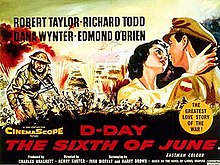Plot
A few hours before D-Day, Special Force Six, a joint American-British-Canadian commando unit, embarks to destroy an especially well-defended German coastal gun emplacement on the Normandy coast. As the landing ship steams towards it, its commander, an Englishman, and one of his subordinates, an American, reflect on their love for the same woman.
Captain Brad Parker, an American paratrooper invalided out because of a broken leg suffered during a parachute jump, is posted to the headquarters of the European Theatre of Operations in London. At the Red Cross club, he meets and, despite being married, falls in love with Valerie Russell, an Auxiliary Territorial Service subaltern. Valerie is the daughter of a crusty brigadier who's been on sick leave since being wounded at Dunkirk. Valerie is also already in love with Lieutenant Colonel John Wynter of the British Commandos, a friend of her father.
Both officers are posted overseas, but later return. Parker has volunteered to join what becomes Special Force Six, to be led by his former commander, Lt. Colonel (now full Colonel) Timmer.
With only a few hours before the operation is due to embark, Timmer goes to pieces (partly as a result of his earlier bad experiences in the failed Dieppe Raid) and is arrested whilst drunk and breaking security (this incident is clearly based on a similar breach of security by Major General Henry J. F. Miller). Wynter, now a colonel, who has recovered from being badly wounded, is brought in to command the operation. The operation is a success, despite several killed and wounded. Parker is badly wounded and evacuated. Wynter is wounded as well, and while he is awaiting evacuation, is killed when he steps on a mine.
In the hospital, and due to be repatriated, Parker sees Valerie for the last time. She does not tell him that Wynter has been killed, and, after a final embrace with Parker, Valerie leaves the hospital with her head hung in despondent loneliness.
Production
Lionel Shapiro (1908–1958) was a Canadian war correspondent for The Montreal Gazette who landed at the Allied invasion of Sicily, Salerno and Juno Beach on D-Day with the Canadian forces. [3] His 1955 romantic novel The Sixth of June was awarded the Governor General's Award for English-language fiction. As opposed to a historical account such as The Longest Day , The Sixth of June is a love triangle of adulterous relationships set in war such as The Man in the Gray Flannel Suit that was also filmed by 20th Century Fox in 1956. Robert Taylor echoes his appearance in Waterloo Bridge by wearing a trenchcoat and romancing English lady Dana Wynter. Wynter called it her favorite of all her films, being an unresolved love story. [4]
Though originally planned to be filmed in Britain with Jean Simmons as the female lead, The Sixth of June (the working title of the film) was made on the Fox backlot with naval scenes filmed at the Long Beach Naval Shipyard, featuring the hospital ship USS Haven (AH-12), whilst the beach landing was made at Point Dume California. [5] Before the days of computer-generated imagery director Henry Koster had to make his landing look convincing on his limited budget with two LCVPs and eighty soldiers. [6] In the invasion scene soldiers running out of the two landing craft appear in front of a back projection scene of another take of the same scene giving the appearance of twice as many landing craft and soldiers as there actually were.
Unlike many American war films D-Day the Sixth of June presents the viewpoints of British characters and features Canadian troops in action. The film's microcosm version of the Normandy landings is a Pointe du Hoc type assault featuring an imaginary "Special Force Six" made up of British, American and Canadian troops in equal quantities. When Taylor's character is wounded it is Todd and the British and Canadians who destroy the big gun that is the force's objective.
According to Todd, in the original script his character lived and Taylor's character went back to his wife. However Todd requested that his character be killed. [7]
Edmond O'Brien's character is relieved of command in a similarity to US Army Ranger Major Cleveland A Lytle. Lytle who was to command three companies of the 2nd Ranger Battalion in the assault at Pointe du Hoc heard that Free French sources reported the guns thought to be there had been removed. Lytle became quite vocal that the assault would be unnecessary and suicidal and was relieved of his command at the last minute by Provisional Ranger Force commander Colonel James Rudder. [8] Rudder felt that Lytle could not convincingly lead a force with a mission that he did not believe in. [9] Lytle was later transferred to the 90th Infantry Division where he was awarded the Distinguished Service Cross. [10]
Technical adviser Colonel Dan Gilmer had been General Eisenhower's Secretary in SHAEF during the D-Day preparation and landings. [11]

Omaha Beach was one of five beach landing sectors of the amphibious assault component of Operation Overlord during the Second World War.
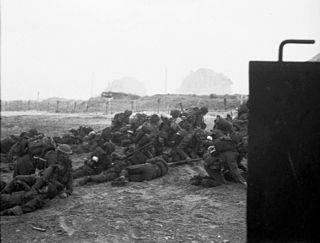
Sword, commonly known as Sword Beach, was the code name given to one of the five main landing areas along the Normandy coast during the initial assault phase, Operation Neptune, of Operation Overlord. The Allied invasion of German-occupied France commenced on 6 June 1944. Stretching 8 kilometres (5.0 mi) from Ouistreham to Saint-Aubin-sur-Mer, the beach proved to be the easternmost landing site of the invasion after the abortion of an attack on a sixth beach, code-named Band. Taking Sword was to be the responsibility of the British Army with sea transport, mine sweeping and a naval bombardment force provided by the British Royal Navy as well as elements from the Polish, Norwegian and other Allied navies.
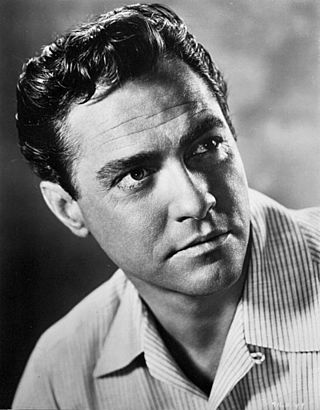
Richard Andrew Palethorpe-Todd was an Irish-British actor known for his leading man roles of the 1950s. He received a Golden Globe Award for Most Promising Newcomer – Male, and an Academy Award for Best Actor nomination and a Golden Globe Award for Best Actor nomination for his performance as Corporal Lachlan MacLachlan in the 1949 film The Hasty Heart. His other notable roles include Jonathan Cooper in Stage Fright (1950), Wing Commander Guy Gibson in The Dam Busters (1955), Sir Walter Raleigh in The Virgin Queen (1955), and Major John Howard in The Longest Day (1962). He was previously a Captain in the British Army during World War II, fighting in the D-Day landings as a member of the 7th Parachute Battalion.

The Normandy landings were the landing operations and associated airborne operations on 6 June 1944 of the Allied invasion of Normandy in Operation Overlord during the Second World War. Codenamed Operation Neptune and often referred to as D-Day, it is the largest seaborne invasion in history. The operation began the liberation of France, and the rest of Western Europe, and laid the foundations of the Allied victory on the Western Front.

Pegasus Bridge, originally called the Bénouville Bridge after the neighbouring village, is a road crossing over the Caen Canal, between Caen and Ouistreham in Normandy. The original bridge, built in 1934, is now a war memorial and is the centrepiece of the Memorial Pegasus museum at nearby Ranville. It was replaced in 1994 by a modern design which, like the old one, is a bascule bridge.
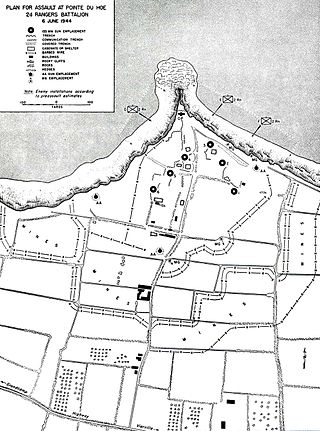
La Pointe du Hoc is a promontory with a 35-metre (110 ft) cliff overlooking the English Channel on the northwestern coast of Normandy in the Calvados department, France.

The Longest Day is a 1962 American epic historical war drama film based on Cornelius Ryan's 1959 non-fiction book of the same name about the D-Day landings in Normandy on June 6, 1944. The film was produced by Darryl F. Zanuck for 20th Century Fox, and is directed by Ken Annakin, Andrew Marton, and Bernhard Wicki. The screenplay was written by Ryan, with additional material written by Romain Gary, James Jones, David Pursall and Jack Seddon.

Norman Daniel "Dutch" Cota Sr. was a senior United States Army officer who fought during World War II. Cota was heavily involved in the planning and execution of the Allied invasion of Normandy, in June 1944, codenamed Operation Neptune, and the subsequent Battle of Normandy. He is known for rallying demoralized troops on Omaha Beach on D-Day, by engaging in combat beside them and personally leading their first successful breakout, for which he was awarded the Distinguished Service Cross (DSC).
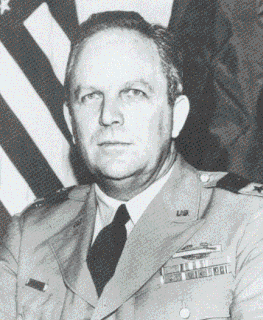
James Earl Rudder was a United States Army major general. As a lieutenant colonel, he commanded the historic Pointe du Hoc battle during the Invasion of Normandy. He also commanded the US troops at the Battle of the Hürtgen Forest, and led a series of delaying actions and ambushes during the Battle of the Bulge. General Rudder also at various times served as Texas Land Commissioner, the 16th president of Texas A&M University, third president of the Texas A&M University System, mayor of Brady, Texas, and a high school and college teacher and coach.

The Brécourt Manor Assault during the U.S. parachute assault of the Normandy Invasion of World War II is often cited as a classic example of small-unit tactics and leadership in overcoming a larger enemy force.
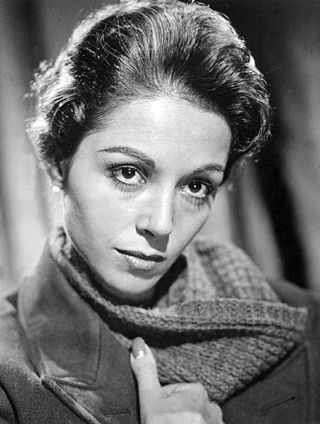
Dana Wynter was a German-born British actress, who was raised in the United Kingdom and southern Africa. She appeared in film and television for more than 40 years, beginning in the 1950s. Her best-known film performance was in Invasion of the Body Snatchers (1956). A tall, dark, elegant beauty, she played both victim and villain. Her characters both in film and on television sometimes faced horrific dangers, which they often did not survive, but she also played scheming, manipulative women on television mysteries and crime procedural dramas.

Operation Overlord was the codename for the Battle of Normandy, the Allied operation that launched the successful liberation of German-occupied Western Europe during World War II. The operation was launched on 6 June 1944 (D-Day) with the Normandy landings. A 1,200-plane airborne assault preceded an amphibious assault involving more than 5,000 vessels. Nearly 160,000 troops crossed the English Channel on 6 June, and more than two million Allied troops were in France by the end of August.

HMS Apollo, the fifth ship of the Royal Navy to be named for the Greek god Apollo, was a fifth-rate frigate of the Lively class, carrying 38 guns, launched in 1805 and broken up in 1856.

Mission Albany was a parachute combat assault at night by the U.S. 101st Airborne Division on June 6, 1944, part of the American airborne landings in Normandy during World War II. It was the opening step of Operation Neptune, the assault portion of the Allied invasion of Normandy, Operation Overlord. Five hours ahead of the D-Day landings, 6,928 paratroopers jumped from 443 C-47 Skytrain troop-carrier planes into the southeast corner of France's Cotentin Peninsula. The troops were meant to land in an area of roughly 15 square miles (39 km2), but were scattered by bad weather and German ground fire over an area twice as large, with four sticks dropped as far as 20 miles (32 km) away.

The 1st Canadian Parachute Battalion was an airborne infantry battalion of the Canadian Army formed in July 1942 during the Second World War; it served in North West Europe, Landing in Normandy during Operation Tonga, in conjunction with the D-Day landings of 6 June 1944 and in the airborne assault crossing of the River Rhine, Operation Varsity, in March 1945. After the end of hostilities in Europe, the battalion was returned to Canada where it was disbanded on 30 September 1945.
The Provisional Ranger Group was a provisional regiment of U.S. Army Rangers that was formed for the D-Day landings in Normandy, France, in World War II.
Colonel Henry John Sweeney MC, known as Tod Sweeney, was an officer of the British Army. During the Second World War he was a platoon commander in the coup de main operation, by gliderborne troops of the 2nd Battalion, Oxfordshire and Buckinghamshire Light Infantry, on D-Day, 6 June 1944, tasked to seize Horsa Bridge and Pegasus Bridge before the main assault on the Normandy beaches began. The following day he was awarded the Military Cross for rescuing a wounded member of his platoon while under heavy fire near Escoville. Sweeney commanded the 1st Green Jackets at Penang from April 1962 to January 1964; during the Brunei Revolt and Indonesia-Malaysia confrontation.

The capture of the Caen canal and Orne river bridges was an operation by airborne forces of the British Army that took place in the early hours of 6 June 1944 as part of the Normandy landings of the Second World War. The objective was to capture intact two road bridges in Normandy across the River Orne and the Caen canal, providing the only exit eastwards for British forces from their landing on Sword Beach. Intelligence reports said both bridges were heavily defended by the Germans and wired for demolition. Once captured, the bridges had to be held against any counter-attack, until the assault force was relieved by commandos and other infantry advancing from the landing beach.

The Battle of Bréville was fought by the British 6th Airborne Division and the German 346th Infantry Division, between 8 and 13 June 1944, during the early phases of the invasion of Normandy in the Second World War.

The June 6, 1944, order of the day was issued by Supreme Commander of the Allied Expeditionary Force General Dwight D. Eisenhower to Allied forces on the eve of D-Day, the first day of the invasion of Normandy. The message was intended to impress upon the troops the importance of their mission which Eisenhower called a "Great Crusade". Eisenhower had been drafting the order since February 1944 and recorded a spoken version on May 28, that was broadcast on British and American radio on D-Day.
